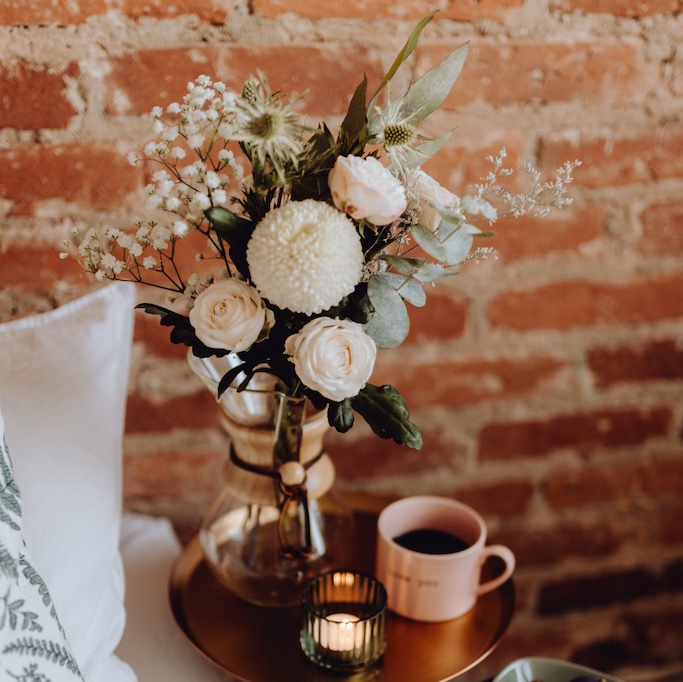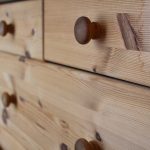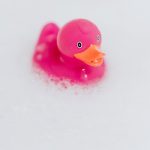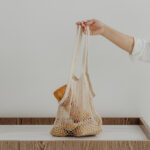
Wondering how to organize a nightstand in your home?
Are you looking for some helpful tips to assist you in putting things in order?
Nightstands are convenient pieces of furniture.
Unfortunately, nightstands can be clutter magnets, attracting everything and anything in sight.
In this post, you’ll find some pointers to help you declutter and organize a nightstand in your bedroom.
You can also apply these tips to any small piece of furniture in your home.
Use them to organize a side table in a living room, a credenza in a home office, or a dry sink in a hallway.
Remove everything from the nightstand.
There’s nothing like starting with a clean slate!
Remove all items on top of and inside the nightstand.
You can move these items onto a clear table top, an open space in the middle of your bedroom, or even a freshly made bed.
You should also take this moment to tidy up and tend to the nightstand.
Vacuum drawers and cubbies, wipe down and polish surfaces, and fix any broken hardware, such as handles and hinges.
Understand nightstand zones.
An easy way to organize a nightstand is to view the nightstand as if it has layers, just like a layer cake.
You’ll be organizing and placing your belongings within each of these defined layers (of course, your mileage may vary).
A typical nightstand has a flat counter top, with perhaps a shallow drawer, or two, and/or a larger storage space underneath.
Here’s a helpful way to view the zones:
- Top layer – Flat top of the nightstand. A place for frequently used items, or items that are on your person during the day.
- Middle layer – Drawer or open area of the nightstand. A place for semi-frequently used items, on a daily or semi-daily basis.
- Bottom layer – Large drawer or open space. A place for infrequently used items, or those too large to fit on top of nightstand, or in a drawer.
Now that you have these zones in mind, you can group items accordingly.
Here’s a list of common nightstand items by zone:
Top layer
- Small lamp
- Clock or alarm clock
- Landline telephone
- Box of facial tissues
- Small decorative pieces or accents
Middle layer
- Flashlight
- Batteries
- Remote controls
- Electronic chargers
- Medication
- Lip balm
- Hand lotion or salve
- Cough drops
- Beverage coaster
- Personal toiletries
- Pencil/Pen and notepad
Bottom layer
- Books
- Lap/Laptop desk
- Reference/Coffee table books
- Larger electronic devices
Take a moment to declutter.
At this point, it should now be easier to see what does, and what doesn’t, belong in your nightstand.
If you’re ever in doubt about what to keep in your nightstand, think about the construction and purpose of the nightstand: it is a small table that is used store items besides a bed.
Typically, items on a nightstand stores leisure, personal, grooming and health, and emergency items.
Leisure items might include books, coloring books, and knitting, while personal items might include watches, fitness trackers, rings, and earrings.
Grooming and health items may include facial tissues, hair brushes, and medication, while emergency items might include a flashlight and batteries.
Anything that doesn’t fit in with the purpose of the nightstand is considered clutter.
These Items should be stored in another room or area of the home.
Assemble your belongings according to zone.
Next, you’re going to round-up your existing nightstand belongings, and assemble them by zone.
You can start placing items on and inside the nightstand at this time, or you can just make three general areas or piles of your things.
I’ll leave it up to you when it comes to ultimately organizing items in your nightstand.
However, you may want to add items to the above mentioned layers for your nightstand, or you may want to remove things, or even move items around.
A box of facial tissues may be stored in a drawer if the drawer is deep enough, or if you prefer having the tissues out of sight.
Find storage solutions.
Once you’ve assembled your belongings, you can find storage solutions for smaller or disparate items.
Store similar items together to keep them neat, tidy, and contained.
Here’s a couple of inexpensive and simple ideas to help keep things in order:
- Top layer – use a decorative tray, bowl, or box to temporarily store watches, fitness trackers, rings, and other jewelry.
- Middle layer – use similar sized and/or uniform small baskets, containers or trays to contain items.
- Bottom layer – use tension rods, book ends, magazine holders and other similar items to store items upright.
How about you? Which of these tips are you going to try out at home? Join the conversation and leave a comment below!





I love my two-drawer night stand, but I have to admit that there are things in there that I only see (or think about) when I’m cleaning it out. Maybe I’ll be a bit more ruthless next time!
Thanks for your comment, Janet. That definitely sounds like a plan!